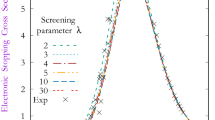Summary
A theoretical determination of magnetic-field effects on the Van der Waals interaction of a neutral atom with a semiconductor surface plasma is reported here. The magnetic field is taken to be perpendicular to the surface, and the semiconductor plasma is taken to be semi-infinite in extent. A local description of the dynamics of the magnetoplasma is employed, and nonlocal structure of plasma response is neglected. The Van der Waals interaction energy is evaluated in second-order perturbation theory to dipole terms, and the effects of a background dielectric constant are included. Our calculational procedure reflects the central role played by the concept of a dynamic plasma image of the neutral adatom in the semiconductor surface. The incorporation of magnetic-field effects, which is carried out here, involves a careful accounting of the anisotropic polarizability of the magnetoplasma in modifying the dynamic plasma image. The explicit evaluation of Van der Waals interaction energy presented here shows that the plasma part of this interaction energy is significantly changed by the magnetic field in semiconductors at field strengths for which the cyclotron frequency is comparable with the plasma frequency. The detailed magnetic-field dependence of the interaction energy obtained here should be subject to experimental confirmation using the highly precise and accurate time-of-flight diffusion method for measuring atom-surface binding energy.
Riassunto
In questo lavoro è riportata una determinazione teorica degli effetti del campo magnetico sulle interazioni di Van der Waals di un atomo neutro con il plasma alla superficie di un semiconduttore. Si è assunto il campo magnetico perpendicolare alla superficie e il plasma del semiconduttore è con un estensione semi-infinita. Si è impiegata una descrizione locale della dinamica del magnetoplasma e si trascura la struttura nonlocale della risposta del plasma. L’energia dell’interazione di Van der Waals è calcolata applicando la teoria delle perturbazioni del second’ordine con termini dipolari, e gli effetti di una costante dielettrica di fondo sono considerati. Il nostro procedimento di calcolo evidenzia il ruolo centrale giocato dal concetto di un’immagine di plasma dinamico dell’atomo neutro sulla superficie del semiconduttore. L’inclusione degli effetti del campo magnetico che è realizzata in questo lavoro prevede un’attenta considerazione della polarizzabilità anisotropa del magnetoplasma nella modificazione dell’immagine di un plasma dinamico. La valutazione esplicita dell’energia dell’interazione di Van der Waals qui presentata mostra che la parte di plasma di questa energia di interazione è variata in modo significativo dal campo magnetico nei semiconduttori a una intensià di campo per la quale la frequenza di ciclotrone è confrontabile con la frequenza del plasma. La dipendenza dettagliata dal campo magnetico dell’energia di interazione ottenuta in questo lavoro dovrebbe essere sottoposta a conferma sperimentale per mezzo dell’altamente preciso e accurato metodo della diffusione del tempo di volo per misurare l’energia di legame atomo-superficie.
Резюме
В этой работе проводится теоретическое определение влияния магнитного поля на взаимодействие Ван дер Ваальса между нейтральным атомом и плазмой на поверхности полупроводника. Магнитное поле перпендикулярно поверхности и плазма полупроводника считается полубесконечной. Используется локальное описание динамики магнитной плазмы. Нелинейной структурой отклика плазмы пренебрегается. Энергия взаимодействия Ван дер Ваальса оценивается во втором порядке теории возмущений по дипольным членам, а также учитываются эффекты диэлектрической постоянной фона. Наша вычислительная процедура отражает центральную роль, которую играет концепция динамического плазменного изображения нейтрального атома на поверхности полупроводника. Учет эффектов магнитного поля приводит к необходимости тщательного описания анизотропной поляризуемости магнитной плазмы при модификации динамического плазменного изображения. Точная оценка энергии взаимодействия Ван дер Ваальса, полученная в этой работе, показывает, что плазменная часть энергии этого взаимодействия существенно изменяется за счет магнитного поля в полупроводниках при значениях поля, для которых циклотронная частота сравнима с плазменной частотой. Зависимость энергии взаимодействия от магнитного поля, полученная в этой работе, требует экспериментальной проверки, используя более точные методы для измерения энергии связи атома на поверхности.
Similar content being viewed by others
References
I. E. Dyzaloshinskii, E. M. Lifshitz andL. P. Pitaevskii:Adv. Phys.,10, 165 (1961).
A. D. McLachlan:Proc. Roy. Soc.,271 A, 387 (1963).
C. Mavroyannis:Mol. Phys.,6, 593 (1963).
J. E. Lennard-Jones:Trans. Faraday Soc.,28, 334 (1932).
D. M. Newns:Phys. Rev. B,1, 3304 (1970).
F. Pollock, H. Logan, J. Hobgood andJ. G. Daunt:Phys. Rev. Lett.,28, 346 (1972).
Author information
Authors and Affiliations
Additional information
Traduzione a cura della Redazione.
Переведено редакцией.
Rights and permissions
About this article
Cite this article
Morgenstern Horing, N.J., Silverman, S. Magnetic-field effects on the Van der Waals interaction of a semiconductor surface plasma with a neutral atom. Nuov Cim B 38, 396–402 (1977). https://doi.org/10.1007/BF02723510
Received:
Published:
Issue Date:
DOI: https://doi.org/10.1007/BF02723510




